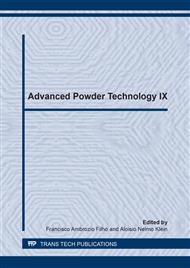p.268
p.274
p.280
p.285
p.291
p.297
p.303
p.311
p.317
Dry Aggregate Particle Size Distribution Optimization for Soderberg Anode Paste Production Applied to Aluminum Industry
Abstract:
For a Soderberg Technology, paste production process consists of four basic steps: raw material handling; dry aggregate preparation; mixing; and briquettes loading at electrolytic cells for aluminum production. Dry aggregate is prepared from calcined petroleum coke, where the grains are crushed and separated between 3 different fractions of pre-determined sizing and a dust component. Petroleum pitch blended with the finest particles from dry aggregate forms the binder used for wetting, lubricating and filling open pores of larger coke grains, resulting into a higher anode paste quality with adequate mechanical properties, higher density, oxidation resistance and lower electrical resistivity. Raw materials recent trends showed significant quality degradation and cost raise, pushing up industry to look forward for untraditional suppliers, in addition to process optimization. This paper describes enablers chosen to improve paste properties, through dry aggregate particle size distribution using two of the most traditional particle packing models: Andreasen and Alfred. The formulations developed in this work were compared to the formulation originally used by an industry through measures flowability and apparent baked density. The results have shown that both the equations of Alfred and Andreasen, for distribution coefficient 0.30 and 0.52 respectively, can be applied to the Aluminum Industry, resulting into products significantly different from the point of view of quality.
Info:
Periodical:
Pages:
291-296
Citation:
Online since:
December 2014
Price:
Сopyright:
© 2014 Trans Tech Publications Ltd. All Rights Reserved
Share:
Citation:


